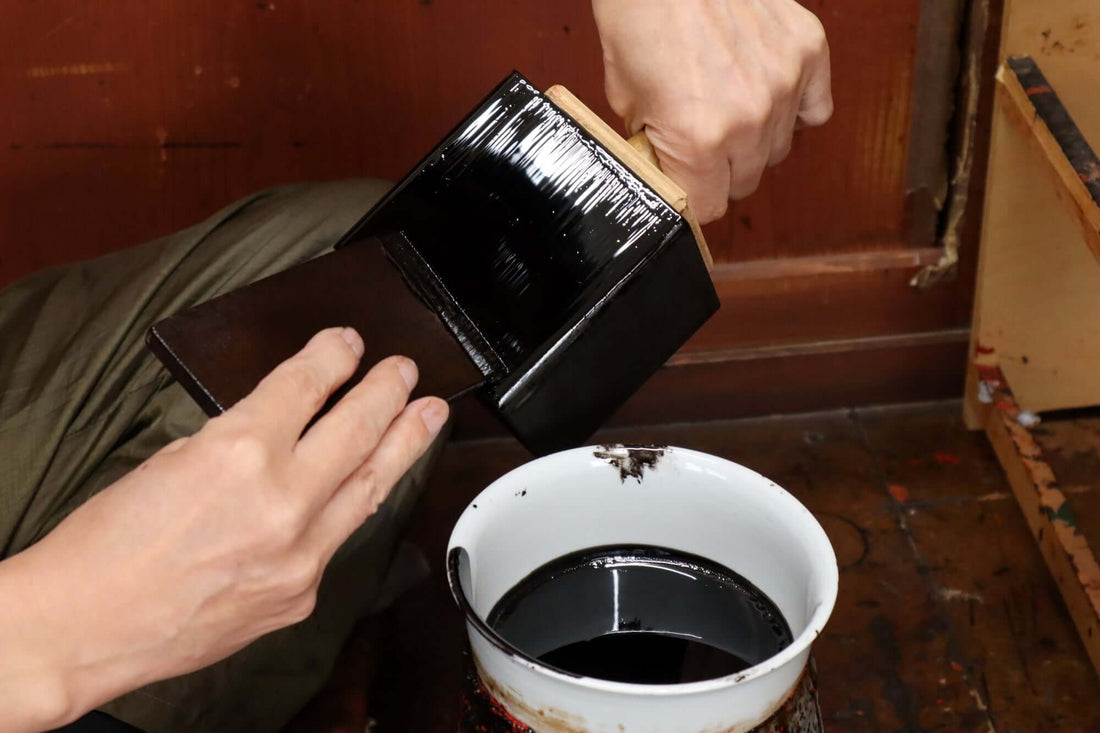
Lacquerware production process
Share
The lacquerware boxes sold by Tozando are made using the following process.

The image above, from left: ① Wood → ② Upholstery → ③ Undercoat → ④ Intermediate coat → ⑤ Topcoat
Lacquerware making is a division of labor system, and is roughly divided into three steps: making the base wood, undercoating, and topcoating. They outsource the basic materials to specialized craftsmen. At Mr. Ootoshi's workshop, his son is in charge of ② and ③ above, and ④ and ⑤ are handled by himself.
When making lacquerware using natural lacquer, each part is coated multiple times and it takes time for the lacquer to dry, so it takes about four months to complete.
①Making the bare wood
Lid → It is made of Chinese plywood from Hokkaido. By stacking a total of 5 boards with alternating grains, the lid is made to resist warping and breakage. By stacking five boards together, they create a durable lid because a single natural board will warp.
Body → Hiba wood from Aomori or Ishikawa prefecture. Along with the lid, the corners are rounded so that it fits comfortably in your hand and prevents the corners from chipping.
②Cloth pasting

Apply baked diatomaceous earth powder and attach cotton cloth to the corners for reinforcement. Lacquerware is used for soba steamers and sushi geta, and since they are washed frequently, they are covered with cloth to ensure longevity.
Tozando's lacquered boxes may not be washed often, but in order to ensure that they can be used for a long time, only the corners are covered with cloth, making them durable lacquerware.
③Undercoat

A mixture of lacquer, rice paste, and tono powder (purified earth) is applied as a base coat. After applying the base coat, polish the surface to improve adhesion with the next coat of lacquer.
④ Intermediate coating ⑤ Top coating
<Black lacquer>

<Red lacquer>

The lacquer used for the intermediate and top coats has a reduced moisture content and is colored. When the intermediate coating is applied, the surface of the vessel is not yet glossy. A top coat creates a beautiful luster. While the intermediate and top coats are being applied, the room is closed to prevent dust from getting on the surface, and only the workers are allowed to enter. This is work that requires a lot of concentration.
Introducing the drying room.

The slow rotation of the internal shaft ensures a flat surface without lacquer building up in the corners.
Lacquer does not dry when there is no moisture, but dries when there is a lot of moisture. It is also said that it takes about 50 years to completely dry to the core. It is a very mysterious and attractive material.
When I spoke to Mr. Ootoshi, he said that unless you handle lacquer every day, you won't be able to tell how dry it is. The drying time varies depending on various factors such as the condition of each lacquer, the season, and the weather, so it was said that a constant dialogue with nature is necessary.
It is a job that not only requires skill in applying lacquer evenly and polishing it smoothly, but also requires many years of experience.












